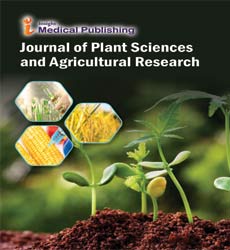Agronomic Quality of Anaerobic Digestate and Its Impact on Antibiotic Resistance Genes in Soil
Nile Rahman*
Department of Plant Sciences, University of Cambridge, Cambridge, UK
- *Corresponding Author:
- Nile Rahman
Department of Plant Sciences, University of Cambridge, Cambridge,
UK,
E-mail: rahmann_n@gmail.com
Received date: November 20, 2024, Manuscript No. IPJPSAR-24-20181; Editor assigned date: November 22, 2024, PreQC No. IPJPSAR-24-20181 (PQ); Reviewed date: December 06, 2024, QC No. IPJPSAR-24-20181; Revised date: December 13, 2024, Manuscript No. IPJPSAR-24-20181 (R); Published date: December 20, 2024, DOI: 10.36648/ipjpsar.8.4.160
Citation: Rahman N (2024) Agronomic Quality of Anaerobic Digestate and It's Impact on Antibiotic Resistance Genes in Soil. J Plant Sci Agri Res Vol.8 No.4: 160.
Description
Anaerobic Digestion (AD) is an important process in waste management and energy production, where organic materials such as agricultural waste, food scraps and sewage sludge are decomposed by bacteria in the absence of oxygen. One of the key products of anaerobic digestion is the Anaerobic Digestate (AD), which is a nutrient-rich organic material that can be used as a soil amendment or fertilizer. Its agronomic quality, which refers to its ability to promote plant growth and improve soil fertility, has made it a valuable resource in agricultural practices. However, the use of AD in agriculture is a subject of concern due to its potential impact on soil health, particularly in relation to Antibiotic Resistance Genes (ARGs), which are increasingly becoming a public health issue.
Agronomic quality of anaerobic digestate
One of the primary benefits of using AD as a fertilizer is its ability to enhance soil fertility by adding organic matter, which in turn improves soil texture, aeration and water holding capacity. Additionally, the addition of nitrogen and other macronutrients from AD can help meet the nutritional needs of crops, potentially leading to higher yields. In particular, the slowrelease nature of nutrients in AD compared to synthetic fertilizers helps reduce the risk of nutrient leaching, thus promoting more sustainable farming practices.
However, while the agronomic advantages of AD are evident, there are also concerns related to the presence of potentially harmful substances, such as pathogens, heavy metals and antibiotic residues, which may be present in the original feedstock materials. These substances can accumulate in AD during the digestion process and could affect soil health and crop safety if not properly managed. The presence of antibiotic residues, in particular, has raised concerns due to its potential to contribute to the spread of antibiotic-resistant bacteria in agricultural environments. The next section discusses how the application of AD may influence antibiotic resistance genes in soil.
Impact on antibiotic resistance genes in soil
The presence of Antibiotic Resistance Genes (ARGs) in soil has become a growing concern due to the potential risks they pose to both human and animal health. ARGs are responsible for the ability of microorganisms to resist the effects of antibiotics, making infections harder to treat. Antibiotic resistance is a significant global health threat and the contribution of agricultural practices to the spread of ARGs is well-documented. The use of animal manure, sewage sludge and AD as fertilizers can introduce ARGs into the soil, where they may persist and transfer to other microorganisms, including pathogens.
When AD is applied to soil, it may introduce not only a variety of nutrients and beneficial microorganisms but also antibiotic residues and ARGs from the feedstock used in the anaerobic digestion process. These ARGs can be transferred from the AD to the soil microbiome, potentially altering the microbial community structure and leading to the selection of antibiotic-resistant strains. The high organic matter content of AD can create an ideal environment for microorganisms to thrive, which may also support the persistence and dissemination of ARGs.
The impact of AD on ARGs in soil is influenced by several factors, including the type of feedstock used, the duration and conditions of the anaerobic digestion process and the application method of the Digestate. Feedstocks like manure, which may contain antibiotics from animal treatments, are particularly likely to carry ARGs. Although the anaerobic digestion process can reduce the levels of some antibiotics and ARGs, it does not necessarily eliminate them entirely. Some studies have shown that certain ARGs can survive the digestion process and persist in the final Digestate.
The application of AD to soil can potentially exacerbate the spread of antibiotic resistance, especially when AD is used in large quantities or applied to soil inappropriately. The interaction between antibiotics in the AD and the soil microorganisms can lead to horizontal gene transfer, where resistant genes are passed between bacteria. This gene transfer can result in the proliferation of resistant strains in the soil, increasing the risk of resistance spreading to crops and even to humans through the food chain.
To mitigate the impact of AD on antibiotic resistance, several strategies can be employed. One approach is to optimize the anaerobic digestion process to maximize the degradation of antibiotics and reduce the levels of ARGs in the inal Digestate. Additionally, pre-treatment of feedstocks, such as the use of higher temperatures or chemical additives, can help reduce antibiotic residues and ARGs before the AD process. Moreover, monitoring the concentration of antibiotics and ARGs in AD and implementing appropriate regulatory frameworks for AD use can help ensure that this valuable resource is applied safely and sustainably.
Open Access Journals
- Aquaculture & Veterinary Science
- Chemistry & Chemical Sciences
- Clinical Sciences
- Engineering
- General Science
- Genetics & Molecular Biology
- Health Care & Nursing
- Immunology & Microbiology
- Materials Science
- Mathematics & Physics
- Medical Sciences
- Neurology & Psychiatry
- Oncology & Cancer Science
- Pharmaceutical Sciences
